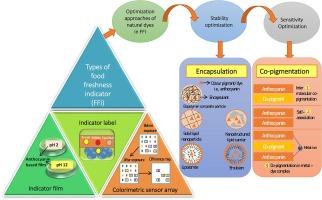基于 pH 值敏感指示膜的易腐食品智能包装系统:过去十年的发展与挑战
IF 4.9
2区 化学
Q1 CHEMISTRY, ANALYTICAL
引用次数: 0
摘要
消费者对实时评估食品新鲜度的非破坏性新系统的需求促使人们开发了基于卤变色或 pH 敏感染料的新鲜度指示器(FI),作为对易腐食品进行智能监测的经济实惠的技术。然而,市场上现有的卤代新鲜度指示器(即新鲜标签、检查点和传感器Q)中使用的传统合成染料的毒性和对健康的有害影响,以及它们监测肌肉食品(即鱼、肉、牛肉和虾)新鲜度状态的唯一目的,引发了人们对开发基于天然 pH 值敏感染料和聚合物基质的无毒、无化学物质和可持续新鲜度指示器的革命性想法的真正担忧。本综述深入探讨了 pH 值敏感染料在化学、组成、生产、食品相互作用、稳定以及在食品领域的广泛应用等方面取得的重大进展。遗憾的是,pH 值敏感型染料在新鲜水果和蔬菜行业中的应用有限,这是因为存在一些挑战,如受高呼吸作用、快速成熟和环境变化等因素的影响,pH 值波动不稳定,无法区分成熟和变质,以及针对特定商品的复杂标准化过程。这些问题都需要进一步研究,以确保在现代易腐食品工业中使用这些智能监测系统。使用 FI 有可能在食品工业改革、提高消费者安全、降低食源性疾病风险方面发挥重要作用,并有助于发展更高效、更可持续的食品供应系统。探索新的天然成分和动植物食品的高灵敏度指标,将推动食品工业在食品成分分析方面的创新。本文章由计算机程序翻译,如有差异,请以英文原文为准。

pH sensitive indicator film based intelligent packaging systems of perishables: Developments and challenges of last decade
Consumers’ demand for novel and non-destructive systems to assess food freshness in real time has led to the development of halochromic or pH-sensitive dyes based freshness indicators (FI) as affordable technique for intelligent monitoring of perishable food. However, the genuine concern regarding the toxicity and deleterious health effect of incorporating conventional synthetic dyes in commercially available halochromic freshness indicators (i.e. fresh tag, checkpoint, and sensorQ) and their sole purpose of monitoring the freshness status of muscle foods (i.e. fish, meat, beef, and shrimp) have led to the revolutionary idea of developing a non-toxic, chemical-free, and sustainable FI based on natural pH-sensitive dyes and polymer matrix. This review delves into significant advances in the chemistry, composition, production, food interaction, stabilization and broad applications of pH-sensitive dyes in the food sector. Unfortunately, the pH-sensitive dyes have reported limited applications in fresh fruit and vegetable industry due to challenges like erratic fluctuations in pH as influenced by factors i.e. high respiration, faster ripening, and environmental changes, inability to distinguish ripening from spoilage, and complex standardization process for specific commodities. These issues merit the demand for further investigations to ensure the utilization of these smart monitoring systems in the modern industry for perishables. The use of FI can potentially play a significant role in reforming food industry, enhance consumer safety, reduce the risk of foodborne illnesses, and aid in the development of a more efficient and sustainable food supply system. Exploration of new natural ingredients and high sensitivity indicators for both animal and plant food products shall drive the innovations in FI for the food industry.
求助全文
通过发布文献求助,成功后即可免费获取论文全文。
去求助
来源期刊

Microchemical Journal
化学-分析化学
CiteScore
8.70
自引率
8.30%
发文量
1131
审稿时长
1.9 months
期刊介绍:
The Microchemical Journal is a peer reviewed journal devoted to all aspects and phases of analytical chemistry and chemical analysis. The Microchemical Journal publishes articles which are at the forefront of modern analytical chemistry and cover innovations in the techniques to the finest possible limits. This includes fundamental aspects, instrumentation, new developments, innovative and novel methods and applications including environmental and clinical field.
Traditional classical analytical methods such as spectrophotometry and titrimetry as well as established instrumentation methods such as flame and graphite furnace atomic absorption spectrometry, gas chromatography, and modified glassy or carbon electrode electrochemical methods will be considered, provided they show significant improvements and novelty compared to the established methods.
 求助内容:
求助内容: 应助结果提醒方式:
应助结果提醒方式:


